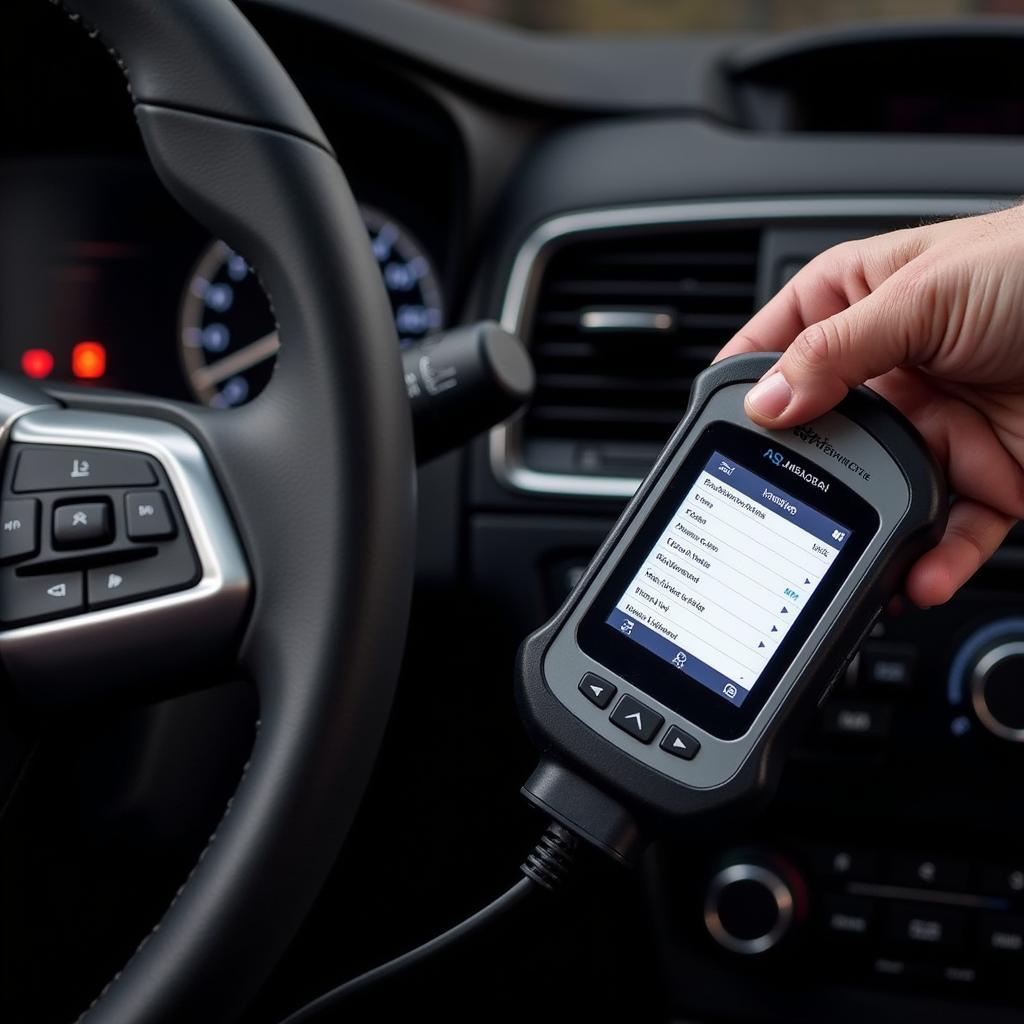Learning how to use a scan tool to program a car’s PCM is essential for any serious DIY mechanic. Reprogramming your Powertrain Control Module (PCM) can fix performance issues, improve fuel economy, and even unlock hidden features. But it’s a delicate process, so understanding the steps and having the right tools is crucial.
 Connecting a Scan Tool to the OBD2 Port
Connecting a Scan Tool to the OBD2 Port
As vehicles become increasingly complex, the PCM plays a more significant role in managing various systems, from engine timing to emissions control. So, whether you’re dealing with a check engine light, want to adjust your car’s performance, or are simply curious about the process, this guide will provide you with a comprehensive understanding of how to use a scan tool to program a car’s PCM. You can find helpful resources and tools on our site, including information on car tools for reprogramming computer.
Understanding the PCM and Its Role
The PCM is the brain of your car’s engine and transmission. It constantly monitors and adjusts various parameters to ensure optimal performance and efficiency. Understanding its function is the first step in learning how to reprogram it. Think of the PCM as a computer constantly running calculations based on data from various sensors throughout your vehicle.
What is a Scan Tool and How Does it Interact with the PCM?
A scan tool, also known as a diagnostic scanner, is an electronic device that connects to your car’s OBD2 port. This port allows the scan tool to communicate with the PCM, retrieving diagnostic trouble codes (DTCs), monitoring live data, and, importantly, reprogramming the PCM. Essentially, it’s the bridge between you and your car’s computer, allowing you to access and modify its programming.
Steps to Program a Car’s PCM with a Scan Tool
Preparing for PCM Programming
Before you start, ensure you have the correct software for your specific car make and model, a stable power supply to prevent interruptions during the process, and a compatible scan tool capable of programming. Remember, different scan tools have different capabilities. Check out our review of the pcmtuner magic car tool for a powerful option.
-
Connect the scan tool: Plug the scan tool into the OBD2 port, usually located under the dashboard on the driver’s side.
-
Turn the ignition on: Turn the key to the “on” position, but do not start the engine. This powers up the scan tool and allows it to communicate with the PCM.
-
Establish communication: The scan tool will establish communication with the PCM. Follow the prompts on the scan tool screen to select the correct vehicle make, model, and year.
Programming the PCM
This stage requires careful attention. Ensure you understand the specific procedures for your vehicle and software before proceeding.
-
Upload the new software: Select the option to program or update the PCM. The scan tool will guide you through the process of uploading the new software to the PCM. This is a critical phase, and any interruptions can damage the PCM.
-
Verify the programming: Once the upload is complete, the scan tool will verify that the new software has been installed correctly.
Post-Programming Procedures
-
Clear DTCs: After successful programming, clear any existing DTCs from the PCM’s memory.
-
Test drive: Take your car for a test drive to verify that the new programming has resolved the issue or achieved the desired performance changes.
Why Would You Need to Reprogram Your PCM?
Reprogramming your PCM can address various issues, such as fixing performance problems, improving fuel economy, updating software to the latest version, and even adding new features. It’s a powerful tool for both troubleshooting and enhancing your vehicle’s performance.
Choosing the Right Scan Tool
The right scan tool can make all the difference. Some smart car diagnostic socket even allow for wireless communication. Consider features like live data streaming, bi-directional controls, and software compatibility when choosing a scan tool for PCM programming.
Conclusion
Learning how to use a scan tool to program a car’s PCM offers a world of possibilities for improving your vehicle’s performance and resolving complex issues. Remember to always follow the manufacturer’s instructions and use the correct software and tools for your specific car make and model. With the right knowledge and tools, you can take control of your car’s computer and unlock its full potential.
FAQ
-
Is it safe to reprogram my car’s PCM myself? Yes, as long as you follow the correct procedures and use the appropriate tools and software.
-
What happens if the programming process is interrupted? An interruption can damage the PCM, potentially requiring replacement.
-
Can I revert to the original PCM software? Yes, you can typically revert to the original software if needed.
-
How often should I update my car’s PCM software? Check with your manufacturer for recommended update intervals.
-
What are the benefits of reprogramming my PCM? Benefits can include improved performance, fuel economy, and updated features.
-
Do I need a special scan tool for PCM programming? Not all scan tools can program a PCM. Ensure your scan tool has this capability.
-
Where can I find the correct software for my car? Reputable software providers or your vehicle manufacturer can provide the correct software.
Common Scenarios
- Check Engine Light: Reprogramming the PCM can sometimes resolve the underlying issue causing the check engine light.
- Performance Issues: PCM updates can improve horsepower, torque, and throttle response.
- Software Updates: Manufacturers release updates to address bugs, improve performance, and add features.
Further Resources
For more information on car diagnostic tools and techniques, explore other articles on our website. You can find helpful resources on topics such as car computer reprogramming and various diagnostic tools.
Contact Us
Need further assistance? Don’t hesitate to contact us via WhatsApp: +1(641)206-8880, Email: [email protected] or visit us at 910 Cedar Lane, Chicago, IL 60605, USA. Our 24/7 customer support team is always ready to help.

Leave a Reply